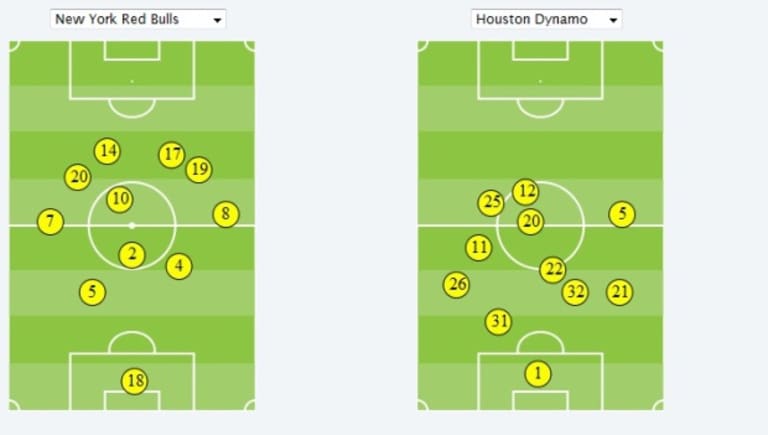Thanks to Major League Soccer’s new game-day statistics partner Opta, there is a lot more data to be had about MLS games in 2011. Here are a few quick observations from Saturday night’s Houston-New York match (FULL RECAP), keeping in mind statistics may be reviewed and updated early in the week:
Team Numbers
As
in the Seattle game, the Dynamo were outshot (22-9) and outcrossed (28-10) by a
significant margin. The second half definitely swung in New York’s favor, with
a 15-5 shot edge. Of the Red Bulls’ 22 shots on the game, 16 were identified as
coming from inside the penalty area, one reason for Tally Hall’s increased
workload and for the Dynamo’s five blocked shots. Hall was credited with eight
saves by Opta, but both New York and Houston statisticians on-site had him with
nine. We’ll see what the official ‘tally’ is later this week.
One stat that seems to mesh with the flow of the game is the percentage of duels won. I do not know exactly how these situations are identified, but Houston won 57.1 percent of duels in the first half, while New York won a sizable 65.8 percent in the second half.
Offensive
Individually,
New York’s offensive efforts were fairly balanced, with Thierry Henry and Joel
Lindpere leading the way with five shots each. Although 18-year-old Juan
Agudelo was active in his third game in eight days, he only got off three shots,
and none were on target.
For the Dynamo, Danny Cruz's numbers stood out offensively, as he made three “key passes” (tied for second in the game behind Lindpere) and got in a team-high five crosses, two of which were termed “good.” Rookie forward Will Bruin came up with two key passes, one a cross on Geoff Cameron’s 10th-minute chance, and the other the flicked header to set up Cam Weaver’s goal.
Defensive
Defensively,
Bobby Boswell and Hunter Freeman seemed the busiest of the backs, statistically
speaking, combining for 14 of Houston’s 27 clearances. That could be due to New
York’s increased presence on the left-hand side, going against Cruz and Freeman
rather than facing Corey Ashe and Brad Davis. As it turned out, Davis led the
team with four interceptions.
Anecdotally, one of the aspects of the game that stood out to me were several matchups between Cameron and Rafa Marquez, and although the head-to-head plays are not broken down, Marquez won 66.7 percent of his duels (8/12), while Cameron won an uncharacteristic 38.5 percent (5/13). Remember that Cameron was questionable during the week due to a hamstring injury and may not have been at 100 percent. Several Dynamo players won more than 50 percent of their duels, namely Lovel Palmer (4/4), Davis (4/5), Brian Ching (3/4), Freeman (3/4), and Ashe (5/9).
For New York, center backs Marquez and Tim Ream combined for 170 passes attempted, including 42 completed to each other. Left-sided players Lindpere and Roy Miller also connected often, finding each other 40 times (again on Houston’s right side). For Houston, Davis completed 12 passes to Cameron inside and seven passes to Ashe overlapping outside.
Tactical

One
of my favorite parts of the Opta data is the tactical formation option, which
averages the location of each player’s touches to indicate where he was most
active. Although it does not, to my knowledge, catalogue movement off the ball,
tactical formation provides a great look at team shape, and the contrast can be
fascinating. For instance, in this game, one can see that New York was pushed
higher up the field, with its outside midfielders pushing up toward the
forwards and its outside backs pushed forward. On the Houston side, the
difference in position of Cruz and Davis indicates the game’s pattern.
It should be noted that these graphics, on a team level, only deal with starters. Weaver’s map would likely have placed him higher on the pitch than Bruin, for example. They can also be affected by set pieces, which might pull a player like Davis toward the corner, but things seem to even out for players with a lot of touches.
It’s still hard to know just what to make of all this data, with league-wide numbers not yet available and virtually no benchmarks, but Opta’s numbers can still show us a few things about the game.
For more game-day numbers, follow Opta’s MLS coverage on Twitter via @OptaJack.




